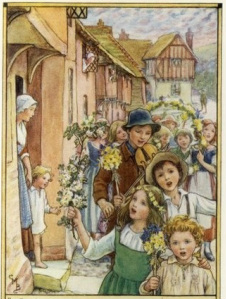
2. The procession of St. Mark's day is said to have been instituted by Pope Gregory the Great at the time when, in consequence of a great inundation, a pestilence was raging in Rome and vicinity. The symptoms of this dread disease were, yawning or sneezing until the victim dropped dead. Hence originated the custom of saying ''God bless you'' when one sneezes; also of making the sign of the cross on the mouth when yawning. To ward off this terrible disease Pope Gregory commanded a solemn procession to be held, and appointed it to be solemnized yearly on the 25th of April; it must have been, however, an ancient custom, but only became general on the occasion of the pestilence. In the beginning of spring, when all nature awakes, this procession is held to beseech Almighty God to avert various natural calamities—-the dangers of drought, storm and tempest. The faithful having been reconciled to God at Easter, now beg to be reconciled with nature, in order to receive not the curse of sin resting upon it through the fall of Adam, but instead the blessings of our heavenly Father. This procession then is really the celebration of the resurrection of nature. It is placed upon the 25th of April, being the first day upon which Easter cannot occur; for the spiritual resurrection must be accomplished before the curse of sin can be taken from nature. The Feast of St. Mark, celebrated on this day, is of much later origin and has no connection with it.
3. On the three days preceding the Feast of the Ascension, processions are also held, therefore this week is called ''Rogation Week," from the Latin ''rogare"—to ask or to pray. The holy bishop Mamertus of Vienne, France, was the first to introduce these processions towards the close of the fifth century to avert various temporal calamities; they found imitation in France, then gradually throughout Christendom. Formerly these days were days of fast and abstinence, as well as of rest from servile work.
4. These processions have a twofold object, namely, to be reconciled with God by penance, and by prayer to obtain new graces and benefits. Our prayers should be for temporal and spiritual blessings: the prosperity of the harvest, preservation from evil, the love of God and freedom from sin. All these requests are contained in the Litany of the Saints, which is prayed on these days, either in the church or in the processions. The special Mass for these days is read in violet, the penitential color, and is intended to increase the confidence of the faithful, and to enhance the efficacy of their prayers.
5. Processions may be held on other extraordinary occasions to avert great calamities; their celebration is the same as those of Rogation week.
-The Ecclesiastical Year, Imprimatur 1903 -
| may_day.pdf |


 RSS Feed
RSS Feed